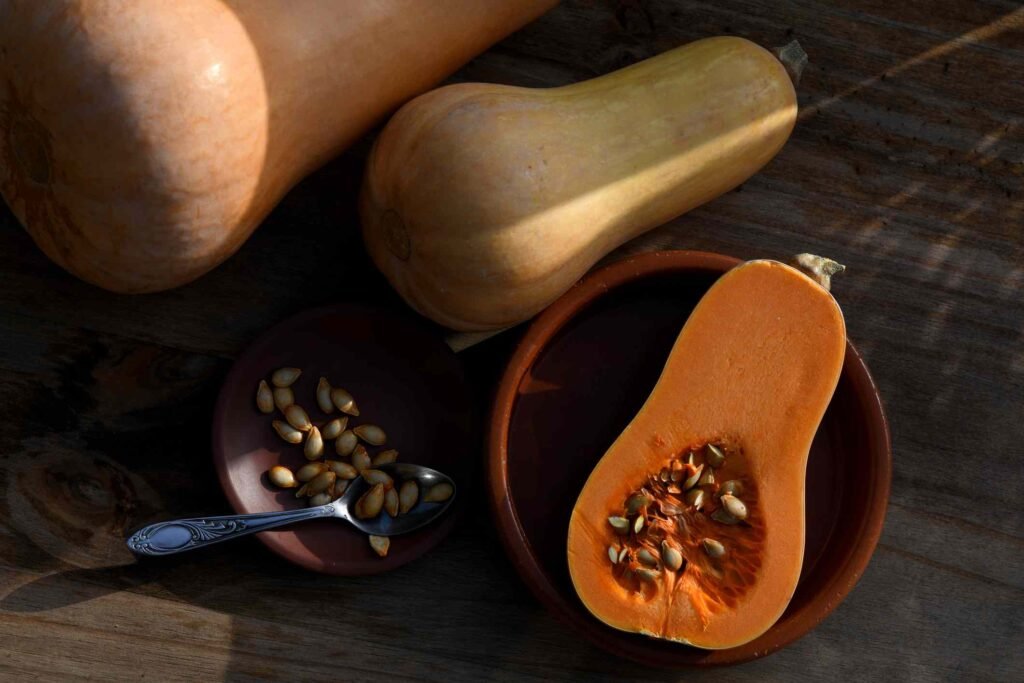Not only is butternut squash delicious and comforting, it’s also packed with nutrition. It has an impressive amount of beta-carotene and other antioxidants that can help prevent chronic diseases and support other facets of health.
Here are the benefits of butternut squash, plus its nutrition facts, risks, and uses.
Butternut squash contains nutrients that are beneficial for your eyes, particularly vitamin A in the form of beta-carotene. It’s what gives butternut squash its orange color.
Vitamin A is a key component of rhodopsin—a protein in your retina. It’s also important for the conjunctival membranes and cornea to function normally.
Furthermore, beta-carotene—a form of provitamin A that’s also an antioxidant—helps prevent age-related macular degeneration (AMD).
Besides vitamin A, butternut squash also contains vitamin C, another antioxidant that can help prevent and treat early AMD. Interestingly, some of the highest concentrations of vitamin C in your body are found in your eyes. Researchers believe that eating more dietary vitamin C (as opposed to taking supplements) may lower the risk of developing cataracts, but more research is necessary to confirm this.
Another antioxidant found in butternut squash, vitamin E, may also prevent and treat early AMD. It can also prevent oxidative stress linked with eye diseases like cataracts.
The research is largely inconclusive on whether supplementation of any of these nutrients individually helps prevent these eye diseases, so getting them in through foods is especially important.
Butternut squash is a plant food packed with fiber, vitamins, minerals, and antioxidants. As a result, it may help prevent against chronic disease.
Fiber is a nutrient many Americans don’t consume enough of, yet it’s associated with a decreased risk of cardiovascular disease and better blood sugar control.
Meanwhile, the antioxidants in butternut squash can protect against oxidative stress, which is linked to cardiovascular disease, cancer, neurological diseases, respiratory diseases, and more.
For example, a large meta-analysis found that higher dietary intake of beta-carotene was linked to reduced risk of lung cancer for non-smokers. Additionally, an umbrella review of dozens of studies found that vitamin C intake was linked to reduced risk of various cancers and cardiovascular disease.
The antioxidants in butternut squash, particularly vitamin C, are also essential for skin health.
Eating enough vitamin C is key because a vitamin C deficiency can cause fragile skin, poor wound healing, and bleeding gums. Furthermore, vitamin C works with vitamin E to protect your skin against harmful UV rays. It’s also necessary to form collagen—a protein that gives your skin its structure and elasticity.
Besides protecting against harmful UV rays, vitamin E may also protect against acne and other skin conditions because of its antioxidative effects. However, more research needs to be done as to how consumption of vitamin E impacts various facets of skin health.
One cup of butternut squash contains 10% of the daily value (DV) of fiber. Fiber is linked with better gut health and bowel regularity, and most Americans could stand to eat more of it.
Eating enough fiber and prebiotic-rich foods can also help foster a healthy gut microbiome. A healthy gut microbiome is linked not only with better gut health but also better immune and mental health.
So, eating butternut squash and other sources of fiber like fruits, vegetables, nuts, seeds, and whole grains is important to promote your digestive health.
Butternut squash is low in fat and sodium and packed with fiber and micronutrients. It’s mainly a source of carbohydrates, and its fiber can promote satiety. One cup (140 grams) contains:
- Calories: 63
- Fat: 0.14 grams (g)
- Carbohydrates: 16.4 g
- Fiber: 2.8 g, or 10% of the DV
- Sodium: 5.6 milligrams (mg)
- Added sugars: 0 g
- Protein: 1.4 g
- Vitamin C: 29 mg, or 32% of the DV
- Vitamin A: 745 micrograms (mcg), or 83% of the DV
- Vitamin E: 2 mg, or 13% of the DV
In addition to being an abundant source of vitamins A, C, and E, one cup of butternut squash also contains 10–12% of the DV of magnesium, potassium, copper, niacin, manganese, and thiamin.
As you can see, butternut squash is especially abundant in vitamin A. Vitamin A is important for eye health and for the formation and maintenance of heart and lung cells.
Consuming excess beta-carotene from butternut squash may result in carotenoderma, a harmless condition where the skin turns yellow-orange. You can reverse this skin reaction by pausing consumption of vitamin A-rich foods or supplements.
This is distinct from consuming excess pre-formed vitamin A—the kind found in meat and dairy–which can lead to adverse effects like severe headaches, blurred vision, coordination problems, and potentially even death in extreme cases.
Butternut squash is easy to eat alone or in combination dishes. You can even use it in baked goods. Here are some ideas for adding more butternut squash to your diet:
- Toss it with olive oil and roast it
- Add roasted butternut squash to salads or grain bowls
- Boil butternut squash and puree it to add to baked goods
- Use pureed butternut squash to make a winter soup or pasta sauce
- Substitute potatoes for butternut squash to make fries or a mashed side dish
- Cut it in half, roast it, and stuff it with veggies and grains
- Add it to mac and cheese or risotto for more flavor
- Make a curry with butternut squash and greens

